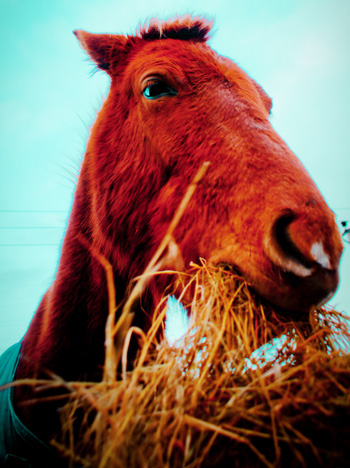Tips for horse hay producers – Part 1
Understanding some details about your hay-buying customers and their horse’s nutrient requirements can help you fine-tune your horse hay business.
Every rural area of Michigan includes a community of pleasure horse owners. The great majority of horse owners are also hay purchasers. This situation provides opportunities for local farmers to produce and sell hay of appropriate quality and bale type locally, either as a sideline or main enterprise. The horse hay market involves direct producer-to-consumer sales and personal relationships, which can be a source of satisfaction or frustration to everybody involved depending on  circumstances. Understanding horse hay quality factors and the needs of local horse owners is important for success in this market, especially with the recent steep increase in hay prices.
circumstances. Understanding horse hay quality factors and the needs of local horse owners is important for success in this market, especially with the recent steep increase in hay prices.
A survey conducted in 2008 by Krishona Martinson, equine extension specialist for University of Minnesota Extension, questioned 50 people attending various horse hay programs in Minnesota. While not a Michigan study, it is reasonable to expect that the results could be similar here. A few key results follow:
- 69 percent of horse owners bought 100 percent of their hay, 23 percent bought some and grow some, and 9 percent grew 100 percent of their hay.
- 57 percent fed small square bales only, 26 percent fed a mixture of both large and small bales, 12 percent fed large square bales only, and 5 percent fed large round bales only.
- 78 percent fed a mixture of grass and alfalfa, 21 percent fed pure grass, and 2 percent fed pure alfalfa.
- When asked why they fed the type of hay they fed, 45 percent responded they fed what they thought was best for their horse, 42 percent fed whatever they could get (what was available), 9 percent worked with their vet, and 5 percent worked with a nutritionist.
- 78 percent had not had their hay tested for nutritional quality, 20 percent had their hay tested.
- 72 percent of participants owned one to five horses, 66 percent were female, and 80 percent were 30 to 69 years old.
Horse hay suppliers should have some knowledge of equine nutrition requirements. Martinson suggests the following:
- Non‐exercising, non‐reproducing adult horses. Nutrient requirements can be met by good quality grass hay alone.
- Working horses. Nutrient requirements are determined by the intensity and duration of exercise. To meet the increased requirements of working horses, cereal grain-based concentrates are often included in the daily ration.
- Growing horses. Energy and nutrient requirements are greatly influenced by their stage and rate of growth. Percentage of hay in daily ration: 75 percent. Percentage of concentrate in daily ration: 25 percent. Good quality grass hay, alfalfa and grass/alfalfa mixed hays can be used in feeding programs for young growing horses due to their higher protein requirement and the higher protein content in legumes and immature grasses.
A good, basic understanding of customer needs will help farmers communicate with horse hay purchasers more effectively, and perhaps provide a little education when needed. The Minnesota survey indicated that 43 percent of the people who participated had owned horses for less than five years.
Refer to the study “Horse Hay Trends and Marketing Strategies“ by Martinson for full details.
Michigan State University Extension provides extensive information on hay production and marketing and care and feeding of horses through several avenues, including our website (click on “Agriculture” then select the topic you are interested in), publications and MSU Extension staff.
MSU Extension’s Equine Feed and Welfare Resources provides links to articles of interest to horse hay producers and purchasers.
Read Part 2 of this series: “Tips for horse hay producers – Part 2.”



 Print
Print Email
Email




